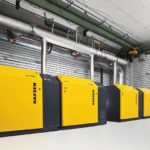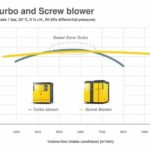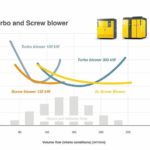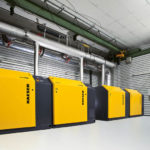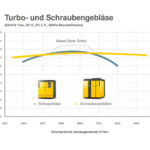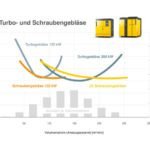Operating companies have a broad spectrum of blowers from which to choose. The most common types of machine are rotary lobe blowers, rotary screw blowers and turbo blowers, which tend to generate differential pressures between 0.4 and 1.0 bar at flow rates up to 250 m³/min. When it comes to generating oil-free compressed air in the low pressure range, there are basically two different types of technology available: positive displacement compressors, which include both twin-shaft rotary lobe blowers and rotary screw compressors, and dynamic compressors, which include turbo blowers. Kaeser Kompressoren offers all types of blowers and provides support in selecting the right solution.
Robust rotary lobe blowers
Viewed from their cross-section, the male and female rotors on a rotary lobe blower appear virtually identical; both feature three lobes and run longitudinally in a straight line. There is no pressure build-up within the blower block itself. Rather, it builds up in the process lines on account of the air molecules constantly pushing against the prevailing resistance generated by the blower. Robust and inexpensive to maintain, rotary lobe machines are recommended where differential pressures between 0.2 and 0.5 bar are required. Depending on the size of the machine, they can reach blower speeds from 2000 to 6000 min-1 and a control range of up to 1:3. When combined with an integrated frequency converter, they achieve an isentropic efficiency between 45 and 60 %. Since the development of rotary screw blowers, rotary lobe blowers tend only to be used when low pressures and short running periods are called for – as with filter backwashing, for example, or for applications featuring strong pressure fluctuations and long idling periods, such as the pneumatic conveyance of bulk materials.
High-efficiency rotary screw blowers
Rotary screw blowers are equipped with two screw-shaped rotors, which interlock together. Compression takes place inside the airend. As the rotors turn, the volume of the intake air trapped in the grooves is constantly reduced, and thus internally pre-compressed. Rotary screw blowers are high-efficiency machines, ideal for differential pressures ranging from 0.4 to 1.1 bar and capable of achieving a control range of 1:4. When combined with an integrated frequency converter, they achieve an isentropic efficiency between 60 and 78 %, which remains stable even at constant pressure and a varying flow rate. The latest models are available with flow rates ranging from 5 to 165 m3/min and, depending on size, can achieve blower speeds from 3000 to 12,000 min-1. These blowers are ideally suited to aeration processes, on account of the need for long operating hours, a broad control range and a constant efficiency curve for the flow rate.
High-speed turbo blowers
In turbo blowers, pressure build-up takes place through an increase in flow speed at the turbo’s impeller, which is subsequently converted into pressure in the diffusor. The classic turbo blower design features a three-phase, asynchronous motor producing impeller speeds from 20,000 to 30,000 min-1 via a transmission. Flow rate and pressure are controlled via an adjustable guide vane, which makes this type of machine on the whole somewhat maintenance-intensive. However, the new generation of turbo blowers, equipped with a high-speed permanent magnet synchronous motor (PMSM) and a frequency converter, are capable of reaching the necessary speeds without need of a transmission. Magnetic-bearing turbo blowers achieve an isentropic efficiency between 60 and 78 %. In contrast to positive displacement compressors, a turbo blower’s peak efficiency is reached within a narrow range and is far more dependent on a particular pressure and flow rate.
A turbo blower’s flow rate varies more starkly with changes in pressure; an initial control range of 1:3 can easily drop to below 1:2. This must be highlighted during the planning phase, in order to avoid any gaps arising in the control range later on.
Turbo blowers are recommended for aeration applications, where the flow rates associated with rotary screw blowers are insufficient when the unit size of the machine is brought into consideration.
Decision guide
When deciding whether turbo blowers, rotary screw blowers, or even a combination of both are best suited to a particular project, it may be useful to consider the following questions: The first criteria to be considered are calculations for the required flow rate, their control range, the required pressure and the potential pressure fluctuations. The second set of decision criteria is concerned with the prevailing operating conditions, i. e. questions concerning the amount of space available and whether the equipment is to be installed indoors or outdoors. Also, the prevailing maximum/minimum ambient temperatures and inlet air temperatures, relative humidity and the existence of any contaminants (particulates, pollen, gas, etc.) in the air. The geographical elevation must also be considered. Reduced ambient/inlet air pressure has an influence on the performance of the machine.
The third set of decision criteria concerns a comparison of both machine and process performance data. What range of flow rate does the machine need to be capable of? Which flow rates are likely to be most frequently required? What is the required control range, both for the design pressure and the maximum expected pressure? What will be the machine’s maximum annual operating hours and how are these distributed across the required flow rate range? How is efficiency affected by the flow rate and how does this match with the most frequently required operating range? What are the total investment costs, including the cost of securing redundant operation? What are the projected maintenance costs and how long will it take to repair the machine in the event of unforeseen failure of an essential component?
It must be borne in mind that the energy costs should not be projected based on one single, ideal operating point, but rather on several points across the expected operating range. Bearing in mind that the annual energy costs for a given product are calculated using the formula cost of electricity x power x operating hours, time is clearly a decisive factor.
Different types combined
It is not altogether infrequent to find that a combination of both types of technology provides the best solution. Particularly in the water treatment industry, where the broadest possible flow rate control range must be covered in the lower ranges, it is increasingly common that air stations operate with a mixture of turbo and rotary screw blowers. Based on the specific output (kW per m3/min), a combination of rotary screw blower and turbo blower is the most efficient solution for covering the flow rate with the highest frequency. A second rotary screw blower can be a cost-effective choice as a redundancy unit.
Kaeser Kompressoren, Coburg, Germany



